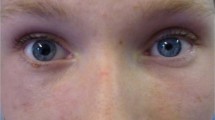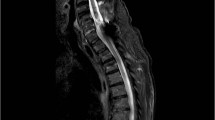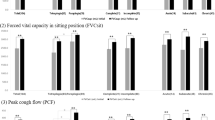Abstract
Introduction
Spinal cord injury (SCI) often leads to impairment of the respiratory system. In fact, respiratory insufficiency is a significant cause of mortality and morbidity following SCI, related to the extent and level of the neurologic injury and its effects on the respiratory muscles (reduction in respiratory muscle strength and fatigue due to a reduction in inspiratory capacity, atelectasis and ineffective coughing). Less commonly recalled is the fact that autonomic dysreflexia (AD) is the result of parasympathetic imbalance. However, AD results from a massive, unrestrained outpouring of norepinephrine from the peripheral sympathetic ganglia. More accurately, the vagal (parasympathetic) response to this sympathetic discharge may have been responsible for the respiratory changes reported. This is not described in medical literature, although breathing difficulty is named as a common symptom and sign. The objective of this report is to describe a clinical case for the first time, that of T4 AIS (American spinal injury association impairment scale) A in which AD leads to acute respiratory insufficiency.
Case report
A patient with prior history of spinal cord injury, T4 AIS A, was admitted to the Inpatient Unit to improve her respiratory function and autonomy and to discontinue the ventilation maintained after an episode of pneumonia. The patient developed AD during the rehabilitation programme, namely during hamstring stretching exercises. Besides persistent hypertension, cutaneous rash, hyperhidrosis and light-headedness, the patient was diagnosed with acute respiratory insufficiency, with desaturation and hypercapnia. The patient fully recovered, in terms of the signs and symptoms of AD, with the cessation of noxious stimulation and oxygen administration.
Discussion
To date, the association between AD and acute respiratory insufficiency has not been described in spinal cord injury or rehabilitation literature. This case draws attention for the first time to the possibility that respiratory insufficiency is one of the signs associated with episodes of AD and highlights the need to look at this possibility.
Similar content being viewed by others
Introduction
Respiratory complications are the main cause of morbidity and mortality in the acute phase of SCI. Approximately two-thirds of patients will experience complications such as atelectasis, pneumonia and respiratory failure, and will require mechanical ventilation [1,2,3]. The degree of respiratory dysfunction is related to the extent and level of the neurological injury. Individuals with cervical and high thoracic injuries are at increased risk of respiratory dysfunction and have a higher rate of dependency on mechanical ventilation [4,5,6,7]. According to the current state of knowledge, there are three factors that can be the cause of respiratory dysfunction in SCI: vital capacity impairment (reduction in respiratory muscle strength and fatigue, a reduction in inspiratory capacity and atelectasis), retention of secretions (ineffective coughing) and autonomic dysfunction as a result of parasympathetic predominance (decreased mucociliary activity, bronchospasms and pulmonary oedema) [8,9,10,11,12,13,14,15,16,17,18,19]. If we consider the pathophysiology of AD, it will not be surprising that an SCI can lead to respiratory insufficiency after the acute phase, because of parasympathetic activity through the vagus nerve trying to balance a massive sympathetic response to a strong sensory stimulus below the level of the injury. However, there is no description of the existence of intrapulmonary consequences resulting from AD. Theoretical models were designed based on neuroanatomical damage occurring above T6, leading to constriction of the small airways (bronchospasm) and consequently acute relapse of the ventilatory state. Moreover, this pathologic pattern can cause an increase in the secretions produced and pulmonary oedema [8]. However, the cause or mechanism of how of intrapulmonary consequences occur resulting from AD is still an unknown phenomenon [20]. Using the clinical case of a patient with SCI below the respiratory motor control centre, we intend to describe how AD can be a potential cause of respiratory insufficiency.
Case report
A 27-year-old woman with complete T4 injury, AIS A, since childhood, secondary to posterior medulloblastoma, was admitted to the SCI Unit to improve her respiratory and functional autonomy in activities of daily living. This patient had a tracheostomy 10 years previously and had been continuously ventilated with invasive ventilation (IV) in Bilevel Pressure Airway mode for 5 months after pneumonia. As ventilation is not expected to be necessary with this level of injury, she was admitted to our Unit to make an attempt to withdraw the ventilator and close the tracheostomy.
At the same time, the patient had marked paralytic thoracolumbar scoliosis (Cobb angle 41) which, together with muscle deconditioning, had led to increased respiratory work, causing discomfort and dyspnoea following minor exertion. Although the respiratory condition presented was predominantly compatible with a restrictive pattern, assessments using functional respiratory tests demonstrated some component of mixed respiratory insufficiency. Functionally, the patient was always dependent on assistance for personal hygiene, dressing and transfer to a wheelchair. She was independent in terms of eating and grooming and was able to aspirate her own secretions by tracheostomy. She had passive joint limitations in the lower limbs (predominantly in the left), mostly due to shortening of the hamstring muscles.
In the inpatient unit, she started a programme of implemented inspiratory and expiratory muscle-strength training, namely the diaphragm, scalene, sternocleidomastoid, external and internal intercostal muscles. At the same time, she was given nebulisation with salbutamol and ipratropium bromide, postural drainage, cough assistance, endurance exercises and progressive ventilator-free breathing. A 24-h oximetry record was prepared, and a series of arterial blood gas measurements were obtained as shown in Table 1.
After 16 days of individualised work, following a specific rehabilitation plan, the patient was taken off IV by tracheostomy. This allowed the patient to lead a life without respiratory symptoms with only nocturnal use of non-invasive ventilation by nasal prongs and an on-demand mouthpiece during the day.
This dramatically improved her comfort and autonomy. At that point, we discussed removal of the cannula from the tracheostomy, which was already closed. During daytime, with the absence of ventilatory support and stable oximetry, episodic desaturation was described during the rehabilitation sessions. We accompanied the patient during the physical therapy session and detected a peak of intense desaturation, reaching 71.1% SpO2 FiO2 21%, secondary to hamstring stretching of the left lower limb (see Table 1). Simultaneously, she began to experience facial and chest flushing, sweating and extensive bowel movement, while also complaining of abdominal cramping, severe headache, dizziness and general discomfort. Her blood pressure was high (peak blood pressure: 210/110 mmHg) and her heart rate low (50 beats per min), demonstrating a typical clinical picture of AD. At the same time, we performed an arterial gas analysis that revealed respiratory failure with hypoxaemia, hypercapnia and acidemia (see Table 2). This episode of AD and desaturation was successfully resolved by suspending the stretching exercises and providing 5-L/m oxygen over 5 min administered by venturi mask® with a target oxygen saturation range of 92–94%.
After this episode, we performed the same assessment with the patient in aerobic training, during and after 30 min of arm cycloergometer exercise at 2.0 W/min. No desaturation was detected during the exercise period, nor signs or symptoms of AD including changes in blood pressure and cardiac frequency. We also verified, at the same time, that arterial blood gas values remained normal.
Discussion
In this case the stretching of the hamstrings caused an AD event. As we know, this result is an uncontrolled sympathetic response through a spinal cord reflex and catecholamine production, with consequent systemic hypertension, sweat production and abdominal cramping. The brain receives this information from baroreceptors through the IX and X cranial nerves and tries to inhibit this sympathetic response through a parasympathetic response. However, since there is an SCI at T4, the inhibition of the sympathetic nervous system and the activation of the parasympathetic system are not effective in lowering the systemic blood pressure. This perpetuates the sympathetic response below the level of the SCI and the parasympathetic response above the SCI, as long as the noxious stimulus continues, which explains the continuous high blood pressure, abdominal cramping, facial and thoracic flushing and bradycardia. However, there is a fact that is rarely explained in AD and is easily understandable in this case report. The acute vagal response to the systemic sympathetic activation causes constriction of the pulmonary airways (bronchospasms). In other words, the loss of sympathetic modulation of cholinergic outflow to the airways results in unopposed bronchoconstriction (Fig. 1). This is evident when observing the arterial blood gas values. During the stretching that caused the AD, there is a lowering of the pO2 and an increase of the pCO2, causing type-2 respiratory insufficiency with an obstructive pattern related to the parasympathetic response. It cannot be interpreted only as a respiratory muscle failure (that would also cause CO2 retention) secondary to paraplegia at T4 or paralytic scoliosis, because during exercise (when respiratory muscles are more prone to fatigue and failure) there is no CO2 increase. This is a paradigmatic case in which there is an evident increase in the parasympathetic tone above the SCI that causes a type-II respiratory failure with CO2 retention due to parasympathetic airways’ bronchoconstriction. This case highlights the importance of considering the possibility of respiratory insufficiency during an AD episode.
References
Brown R, DiMarco AF, Hoit JD, Garshick E. Respiratory dysfunction and management in spinal cord injury. Respir Care. 2006;51:853–68.
Shavelle RM, DeVivo MJ, Strauss DJ, Paculdo DR, et al. Long-term survival of persons ventilator dependent after spinal cord injury. J Spinal Cord Med. 2006;29:511–19.
McCrory DC, Samsa GP, Hamilton BB, et al. Treatment of pulmonary disease following cervical spinal cord injury: summary. AHRQ evidence report summaries, vol. 27, p.1998–2005 Rockville, MD, US: Agency for Healthcare Research and Quality; 2001.
DeVivo MJ. Epidemiology of traumatic spinal cord injury: trends and future implications. Spinal Cord. 2012;50:365–72.
Jackson AB, Dijkers M, Devivo MJ, Poczatek RB. A demographic profile of new traumatic spinal cord injuries: change and stability over 30 years. Arch Phys Med Rehabil. 2004;85:1740–8.
Galeiras Vázquez R, Rascado Sedes P, Mourelo Fariña M, Montoto Marqués A, Ferreiro Velasco ME. Respiratory management in the patient with spinal cord injury. BioMed Res Int. 2013;2013:12.
Bach JR, Saporito LR, Shah HR, Sinquee D. Decanulation of patients with severe respiratory muscle insufficiency: efficacy of mechanical insufflation-exsufflation. J Rehabil Med. 2014;46:1037–41.
Berlly M, Shem K. Respiratory management during the first five days after spinal cord injury. J Spinal Cord Med. 2007;30:309–18.
Silver JR. The history of Guttmann’s and Whitteridge’s discovery of autonomic dysreflexia. Spinal Cord. 2000;38:581–96.
Vázquez RG, Sedes PR, Fariña MM, Marqués AM, Velasco MEF. Respiratory management in the patient with spinal cord injury. BioMed Res Int. 2013;2013:12.
Shavelle RM, DeVivo MJ, Strauss DJ, Paculdo DR, Lammertse DP, Day SM. Long-term survival of persons ventilator dependent after spinal cord injury. J Spinal Cord Med. 2006;29:511–9.
Schilero GJ, Spungen AM, Bauman WA, Radulovic M, Lesser M. Pulmonary function and spinal cord injury. Respir Physiol Neurobiol. 2009;166:129–41.
Linn WS, Spungen AM, Gong JH, Adkins RH, Bauman A, Waters RL. Forced vital capacity in two large outpatient populations with chronic spinal cord injury. Spinal Cord. 2001;39:263–8.
Petrof BJ, Jaber S, Matecki S. Ventilator-induced diaphragmatic dysfunction. Curr Opin Crit Care. 2010;16:19–25.
Vassilakopoulos T, Petrof BJ. Ventilator-induced diaphragmatic dysfunction. Am J Respir Crit Care Med. 2004;169:336–41.
Levine S, Nguyen T, Taylor N, et al. Rapid disuse atrophy of diaphragm fibers in mechanically ventilated humans. N Engl J Med. 2008;358:1327–35.
Haitsma JJ. Diaphragmatic dysfunction in mechanical ventilation. Curr Opin Anaesthesiol. 2011;24:214–8.
Sassoon CSH, Zhu E, Caiozzo VJ. Assist-control mechanical ventilation attenuates ventilator-induced diaphragmatic dysfunction. Am J Respir Crit Care Med. 2004;170:626–32.
Hermans G, Agten A, Testelmans D, Decramer M, Gayan-Ramirez G. Increased duration of mechanical ventilation is associated with decreased diaphragmatic force: a prospective observational study. Crit Care. 2010;14:1–10.
Baumann A, Audibert G, McDonnell J, Mertes PM. Neurogenic pulmonary edema. Acta Anaesthesiol Scand. 2007;51:447–55.
Author information
Authors and Affiliations
Corresponding author
Ethics declarations
Conflict of interest
The authors declare that they have no conflict of interest.
Additional information
Publisher’s note Springer Nature remains neutral with regard to jurisdictional claims in published maps and institutional affiliations.
Rights and permissions
About this article
Cite this article
Andrade, M.J., Quintas, F.L., Silva, A.M. et al. Is autonomic dysreflexia a cause of respiratory dysfunction after spinal cord injury?. Spinal Cord Ser Cases 7, 4 (2021). https://doi.org/10.1038/s41394-020-00372-4
Received:
Revised:
Accepted:
Published:
DOI: https://doi.org/10.1038/s41394-020-00372-4




